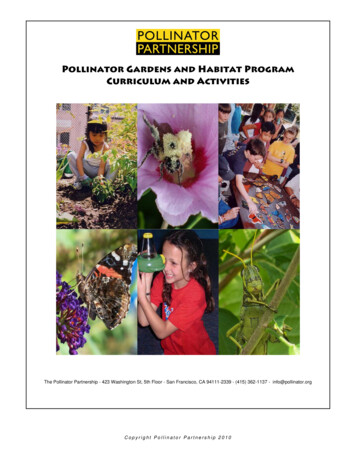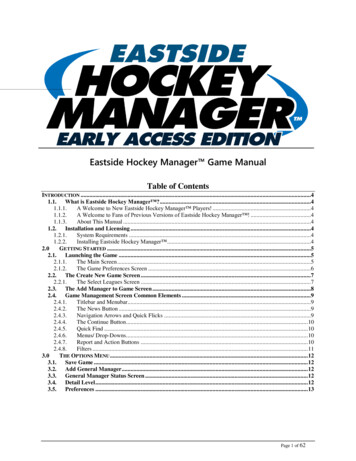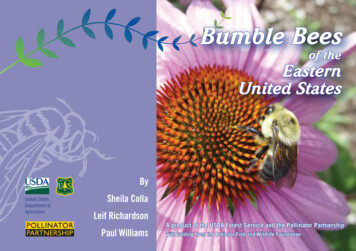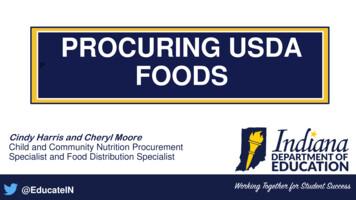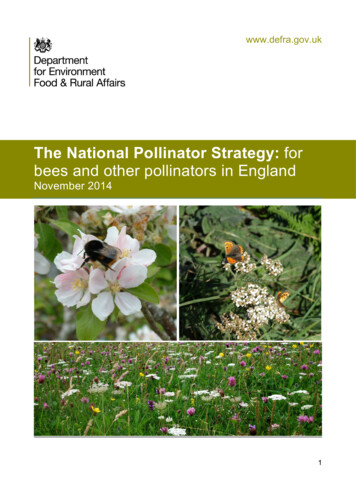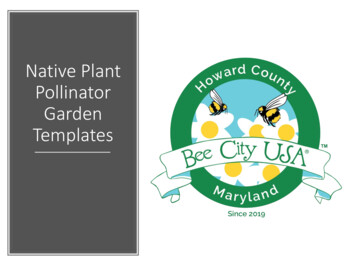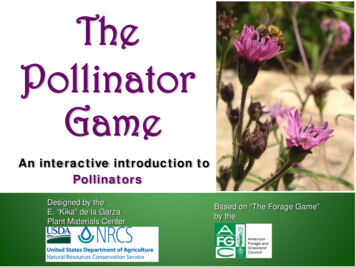
Transcription
ThePollinatorGameAn interactive introduction toPollinatorsDesigned by theE. “Kika” de la GarzaPlant Materials CenterBased on “The Forage Game”by the
How to Play the Game and Learn! Remember this is a game designed to teachyou about pollinators. Do not be concerned if you do not know theanswer to a question. Please close any Internet connections exceptfor the game.
How to Play the Game and Learn! The opening page of thegame looks like this. Use mouse to select anyvalue to reveal ananswer. (Be sure totouch the numberwithin the box.)
How to Play the Game and Learn! For some answers, morethan a simple question ispresented. Be patient or clickwhere indicated. Clickingwill take you to anotherpage or sometimes to theInternet. If you wind up on the Internet, be sure to(close) the Internet link when done.x
How to Play the Game and Learn! If you were correct, tally your points on asheet of paper. Sorry, no points if you were wrong.
How to Play the Game and Learn! When you are finishedwith a question, clickon theto goback to the game pageand select anotherquestion. If you want to see thequestion/answer again, justselect the question again fromthe opening screen. Sorry, no points on do-overs.
How to Play the Game and Learn! When you have gonethrough all thequestions, click onthe NRCS logo at thetop left of theopening screen.Ready to start?
How’d You Score?The Pollinator GamePollinator Name ThatHabitatPollinatorPollinatorBasicsBees 100 100 100 100 100 200 200 200 200 200 300 300 300 300 300 400 400 400 400 400 500 500 500 500 500Flowers
100 Question from Pollinator BasicsWhile they are commonly seen on flowers,are very poor pollinatorscompared to (hairy bodied) bees.
100 Answer from Pollinator BasicsButterflies
200 Question from Pollinator Basicsof the world’s 250,000flowering plants are estimated to rely onanimal pollinators(which includes insects).a) 20% - 40%b) 40% - 60%c) 60% - 80%d) 80% - 100%
200 Answer from Pollinator Basicsc) 60% - 80%To see the Xerces“Pollinators In NaturalAreas” Fact Sheet click here.
300 Question from Pollinator BasicsIn 2000, the estimated economic( ) value of insect pollinated cropsin the U.S. was .a) 5 billionb) 10 billionc) 20 billiond) 50 billion
300 Answer from Pollinator Basicsc) 20 billionThis includes 3 billion incrops pollinated bynative bees.To download the Xerces“2008 Farm Bill Benefitsto Crop Pollinators”Fact Sheet click here.
400 Question from Pollinator BasicsRoughly of globalcrop production relies onanimal pollinators.a) 15%b) 35%c) 55%d) 75%
400 Answer from Pollinator Basicsb) 35%Rice Field87 of the 124 most commoncrops require pollinators.Grains are wind pollinated and do not requireanimal pollinators. Common examplesinclude: corn, wheat, and rice.
500 Question from Pollinator BasicsWhat are the two basic habitatneeds of pollinators?
500 Answer from Pollinator BasicsA diversity of native flowersavailable throughout the season(for food) andegg-laying or nesting sites.
100 Question from BeesThe majority of bee species(about 70%) nest in.(Hint: where?)
100 Answer from BeesThe groundThey dig narrow tunnelsthat lead to a small numberof brood cells(where they raise young).The other 30% nest in woodor other cavities.Mining bee (Andrena)at nest entrance Matthew Shepherd/The Xerces Society
200 Question from BeesThere are about speciesof native bees in North America.a) 500b) 1,000c) 2,000d) 4,000
200 Answer from Beesd) 4,000Native bees range in size from 1/8 inch to 1 inch.To read more aboutnative bees click here.
300 Question from BeesWhich of these is NOT animportant nesting site for bees?a) Bare groundb) Well kept lawnsc) Dead Treesd) Untidy corners of rough grasse) Abandoned rodent nests
300 Answer from Beesb) Well kept lawnsSee the Xerces fact sheetNests for Native Bees to learn more aboutproviding nest sites for bees.To read the fact sheet,click here.
400 Question from BeesHoney bees are not native to theAmericas.How did they get here?
400 Answer from BeesThey were brought over byEuropean colonists.Honeybee onPeach Blossom
500 Question from BeesIn 2006, the National ResearchCouncil reported that in the U.S.both managed honey bee coloniesand wild pollinator populationsshowed significant .
500 Answer from BeesHoneybee Hives Matthew Shepherd/The Xerces SocietyDeclines
100 Question from Pollinator HabitatTrue or False?Adding pollinator habitat to yourland will only benefit pollinators.It will not provide habitat forother wildlife.
100 Answer from Pollinator HabitatFalseFor example: Berries, fruits and seedsproduced by plants after pollination aswell as pollinator larvae (caterpillars)provide food for young birds.
200 Question from Pollinator HabitatResearch suggests that native plantsare times more attractive tonative bees than introduced plants.a) 2 timesb) 4 timesc) 10 timesd) 50 times
200 Answer from Pollinator Habitat4 timesTo download the Xerces“Plants for Native Beesin North America” factsheet, click here.
300 Question from Pollinator HabitatWhat are two important steps increating pollinator habitat?
300 Answer from Pollinator Habitat Cultivate native plants, especially those thatprovide nectar or larval food for pollinators. Supply water for all wildlife. Install houses for bats. Install nest boxes for bees. Supply salt/mineral licks for butterflies.Points for any 2 listed above.
400 Question from Pollinator HabitatButterflies and moths mustlay their eggs on specificfor their larva(caterpillars) to eat.
400 Answer from Pollinator HabitatHost PlantsAdult Queen Butterfly onFrostweedQueen Butterfly Caterpillar onClimbing Milkweed (host plant)
500 Question from Pollinator HabitatName 2 factors (of the many)that have had a negative impacton pollinators.
500 Answer from Pollinator Habitat Loss of floral diversity and habitat due toincreasing urbanization Expansion of intensive agriculture Widespread use of pesticides Disease and parasites Climate change Invasive plantsTo see the Xerces “PollinatorsIn Natural Areas” Fact Sheetclick here.
100 Question from Name That Pollinatorpollinate tomato plants(as well as many nativemembers of the Solanaceae,or “tomato,” family).
100 Answer from Name That PollinatorBumble beesBumble bee approaching a tomato flower Matthew Shepherd/ The Xerces Society
200 Question from Name That Pollinatorpollinate apple flowers.
200 Answer from Name That PollinatorHoneybees andBlue mason orchard beesYou get the 200 points if yougot either answer.
300 Question from Name That Pollinatorpollinate figs.
300 Answer from Name That PollinatorFig Wasps(There are over 800 kindsof fig wasps!!!)
400 Question from Name That Pollinatorpollinate bananas.
400 Answer from Name That PollinatorBirds and Fruit batsYou get the 400 points if yougot either answer.
500 Question from Name That Pollinatorpollinate cranberries.
500 Answer from Name That PollinatorNative beesOver 40 species of native beespollinate cranberries.
100 Question from FlowersWhat are the two mostcommon products producedby plants to attractpollinators?
100 Answer from FlowersPollen and NectarNotice the pollen sacsfull of gatheredpollen.
200 Question from FlowersPollinators assist flowers bymoving from themale parts of the flower(stamens) to the female parts(stigma) of the flower.
200 Answer from FlowersPollenFemale StigmasMale StamensMany plants cannot make seedsor fruits without pollen transfer.
300 Question from FlowersFlowers in the colorsblue, purple, violet, white, andyellow tend to attractas pollinators.
300 Answer from FlowersBeesSome flowers have “lips” that act as landingpads for bees.
400 Question from FlowersRed tubular flowers tend toattractas pollinators.Red SageTurk’s Cap
400 Answer from FlowersHummingbirdsFlower nectar has a ratio of about 1 partsucrose (table sugar) to 3 or 4 parts water.This is why the 1:4 ratio is recommended forhummingbird feeders.
500 Question from FlowersStrong smelling, whiteflowers that bloom or areopen at night tend to attractandas pollinators.
500 Answer from FlowersMoths and Bats
So how did you do? 7000 Excellent!You must have pollinator friends. 5000-7000 Pretty good! 5000 Bet you learned a lot!If you got here by accident,click here to return to the questions.
For More Information: USDA NRCS Plant Materials Program Plant Materials Program - Plants for Pollinators PLANTS NRCS documents for pollinator conservation andenhancement Xerces Society for Invertebrate Conservation North American Pollinator Protection Campaign/PollinatorPartnership (NAPPC) NAPPC Eco-Regional Guides to Pollinator-Friendly Plantings CUS Forest Service - Celebrating PollinatorsIf you got here by accident,click here to return to the questions.
Our Thanks To: Information Sources Xerces Society for Invertebrate Conservation North American Pollinator Protection Campaign The Pollinator Partnership Wildlife Habitat Council Matthew Shepherd/ The Xerces Society for bee photosIf you got here by accident,click here to return to the questions.
The Pollinator Game An interactive introduction to Pollinators Based on "The Forage Game" by the. Designed by the E. "Kika" de la Garza Plant Materials Center


